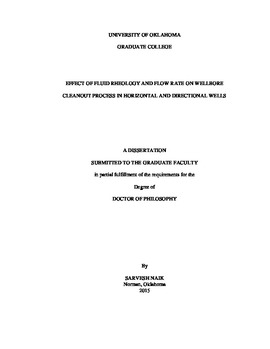| dc.description.abstract | Solids like milled plugs, produced sand or residual proppant are deposited in the wellbore during fracturing operation. These solids can impair hydrocarbon production or cause operational problems, and hence should be removed. Wellbore cleanout is the removal of such solids from the wellbore. Coiled tubing (CT) has found a niche as an economic option for wellbore cleanout and current worldwide estimates indicate cleanout operations account for almost 40% of all CT activities.
Several research efforts have been reported in the literature covering various aspects of wellbore cleanout. These include theoretical, empirical-based approaches or a combination of both to explain the dynamics of solid-liquid transport. Solids transport is affected by flow rate, fluid properties (rheology and density), solid properties (size and density) and wellbore configuration (inclination, annular geometry and eccentricity). A survey of literature suggests that flow rate and fluid rheology are dominant among these while others have a secondary influence on solids transport. A shortcoming in most studies is the failure to account for interaction between parameters. Furthermore, a significant number of investigations focuses on solids transport in drilling with limited information on fracturing operation. Although some success has been recorded, it can be stated that the current state of understanding of wellbore cleanout is incomplete and less than satisfactory.
A comprehensive experimental study of wellbore cleanout using CT was undertaken to understand the effects of flow rate and fluid rheology on solids transport in directional and horizontal wells. An experimental setup with two interchangeable test sections was designed and fabricated to conduct solids erosion tests, which simulate the cleanout of a proppant (solids used in fracturing) bed in the wellbore under various operating conditions. Water, and 10 and 20 lb/Mgal guar fluids were evaluated at flow rates of 80, 100 and 120 gpm each and at inclinations of 45, 60, 75 and 90°. Additionally, solid erosion tests were carried out with a drag reducing fluid, 2.16 lb/Mgal HE 150 at 90°. The cleanout performance of fluid was determined by solids bed erosion and cleanout efficiency.
With increasing flow rate, the solids erosion rate and cleanout efficiency increased for all fluids and inclinations considered. Solids erosion rate and cleanout efficiency were higher at 120 gpm than 80 gpm for all cases considered. Better performance was obtained with water compared to polymeric fluids at 75 and 90° for the flow rates considered. At 45 and 60°, fluids with higher viscosity performed better than those with low viscosity. Thus, 20 lb/Mgal guar fluid performed better than other fluids with decreasing inclination.
For all flow rates considered, the rate of solids erosion for water increased with inclination whereas for polymeric fluids it increased with decrease in inclination. With decreased inclination, the cleanout efficiency increased with fluid viscosity. A 20 lb/Mgal guar fluid performed better at 45° at all flow rates considered.
The data of solids bed height as a function of circulation time was modeled using an exponential decay function. Using a statistical software MINITAB 16, the coefficients of the correlation were obtained. This correlation would aid in predicting the bed height reduction and circulation time for various fluids at different rates and inclination. The correlation predicted the bed height within 10% deviation for all fluids at inclination of 75 and 90°. The deviation for 60° was higher since there was an unstable bed at this inclination which made the bed height predictions difficult.
Dimensional analysis was used to develop dimensionless groups, which were correlated using non-linear regression analysis to obtain correlations for inclinations of 60, 75 and 90°. One set of correlations were obtained for water and another set for polymeric fluids. These correlations can be used to predict solids bed height as a function of circulating time for different fluids and flow rates. The absolute percentage deviation of predictions with the experimental values are 18.13, 21.14, 20.85, 14.64, 21.57 and 8.82 % respectively. | en_US |
